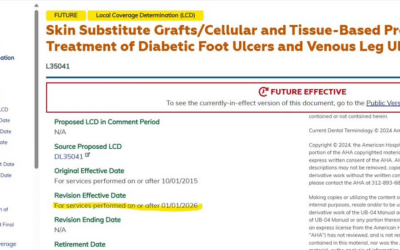Novitas has issued a draft Local Coverage Determination (LCD) for the use of “skin substitutes” (more accurately known as Cellular and/or Tissue Based Products or CTPs) when used for treating Diabetic Foot Ulcers (DFUs) and Venous Leg Ulcers (VLUs). The proposed LCD has been posted to Novitas’ website for comments.
This is Part 5 of the list of what you need to document (per the proposed rule) if you want to use a skin substitute (CTP) for a DFU or VLU. I am pointing out just a few interesting and important things about the way that documentation impacts coverage for CTPs in these two types of chronic ulcerations – based on the proposed rule. Previous blog posts have listed specific areas of documentation that “must” be in the chart. A large section of the policy after that is devoted to a treatise on the “standard of care” (SOC) for the treatment of lower extremity ulcers. This part requires careful interpretation, because only in some places does it specifically state that a certain intervention, test or finding “must” be performed or documented.
I am going to skip their long list of what constitutes SOC (in addition to what has already been discussed) because that section starts with “may include.” I am trying to pick out what appears mandatory in the documentation. I have tried to put my personal comments in italics and use quotations around the policy wording.
Information indicated to be “essential” includes:
- A comprehensive assessment of the patients
- A detailed history of the wound(s)
- “Identifying and correcting systemic causes of impaired healing including severe illnesses and drug treatments (e.g., immunosuppressive drugs and systemic steroids)”
- “A vascular evaluation is also vital for all chronic wounds”
- Note: A detailed and inconsistent discussion of the vascular evaluation is included, but the policy has already stated that you “must” document an ABI, even though in this section it states that it’s necessary if there is a “pulse deficit,” and that the ABI levels may be falsely elevated with medial arterial calcification.
- It then goes on to say that toe blood pressure readings, pulse volume recordings, transcutaneous oxygen measurements (TCOMs), and skin perfusion pressure measurements “have been suggested as acceptable benchmarks for the prediction of wound healing” but remember, the policy has already stated that you “must” do an ABI
- “Venous ulcers require a series of diagnostic testing to verify superficial or deep venous reflux, perforator incompetence, and chronic (or acute) venous thrombosis.”
- I would like to point out that we don’t need venous testing to start treatment for a VLU and that the mere presence of reflux or perforator incompetence does not a venous ulcer make. I enjoy posting cases of cancer, arterial disease, pyoderma and other non-VLUs for which patients underwent venous ablation without benefit before being referred to a wound center for correct diagnosis and treatment. Check out: Does Venous Reflux a Venous Ulcer Make?
The policy then mentions what compression is “recommended,” (it earlier states that there must only be “some” compression) and that a “recommended” SOC treatment schedule for DFUs “includes weekly to monthly wound evaluations of wound size and healing progress, etc., etc. It also says, “adequate glycemic control of hemoglobin A1c (HbA1c < 7%) is also recommended.” I might mention that an A1C level this low is associated with an increased likelihood of death among the frail and elderly based on prospective clinical trials. It is not clear how an auditor will implement all the treatments and studies that are terms ”recommended” vs. those that are listed as “required” in the early part of the policy.
I haven’t covered all the potential problems with the proposed Novitas policy. In case you think you are safe because you live in another MAC jurisdiction, it’s the same as the First Coast policy and it won’t surprise me to see all the MACs adopt the same (flawed) policies. The only hope we have is engagement by folks in the Novitas jurisdiction. If you want to present comments on any part of Novitas proposed LCD, sign up to attend the Open Meeting. Register by the August 24th deadline using the appropriate presenter or observer registration link.





